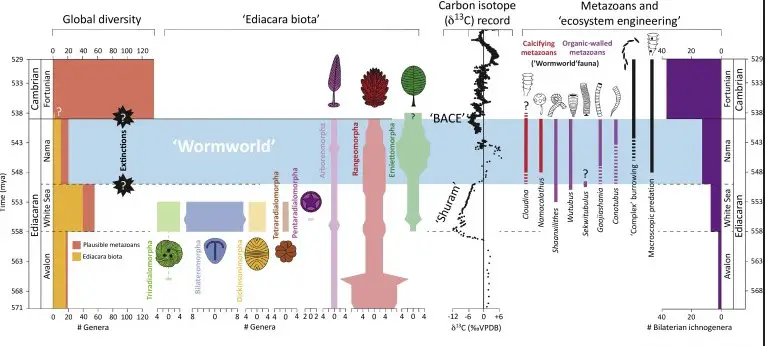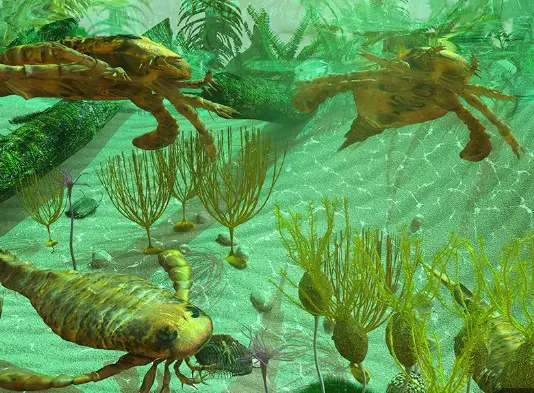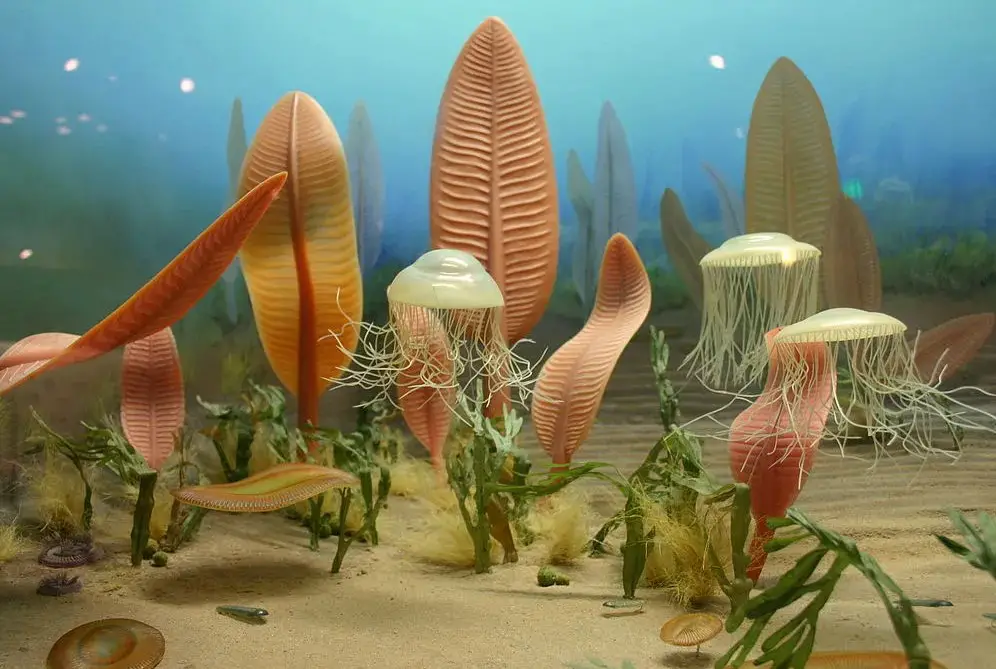The Earth’s history is marked by monumental events that shaped the evolution of life across its diverse landscapes. Among these, the Ediacaran Extinction and the Cambrian Explosion stand out as pivotal periods that transitioned life from primitive forms to more complex organisms. These events, occurring millions of years apart, highlight significant shifts in biological and environmental dynamics.
The Ediacaran Extinction, a less understood phenomenon, involves the disappearance of the Ediacaran biota, which dominated the planet’s pre-Cambrian ecosystems. In contrast, the Cambrian Explosion is noted for its rapid surge in biodiversity, marking the appearance of most major animal phyla. These contrasting events encapsulate a period of dramatic ecological change, laying foundational elements for modern biodiversity.
During the Ediacaran period, which precedes the Cambrian, the Earth was home to a unique assembly of organisms, characterized by their soft-bodied makeup. The extinction of these organisms set the stage for the Cambrian Explosion, where new life forms emerged with characteristics that allowed greater adaptability and diversification. This shift from the simple organisms of the Ediacaran to the complex life of the Cambrian illustrates a dynamic chapter in the Earth’s evolutionary narrative.

Ediacaran Extinction
Context and Timeline
The Ediacaran Period, spanning from approximately 635 to 541 million years ago, represents a crucial phase in Earth’s geological history. This era, named after the Ediacara Hills of South Australia where fossils from this time were first discovered, precedes the explosive diversification of life known as the Cambrian Explosion.
Definition and Time Frame
The Ediacaran Period is defined by its unique biota, which includes some of the earliest complex multicellular organisms. These organisms were predominantly soft-bodied, displaying a variety of bizarre and enigmatic forms, many of which do not seem directly related to any living creatures today.
Geological and Environmental Setting
During this time, Earth’s environment was markedly different from today. The continents were mostly gathered in the supercontinent Rodinia, which began to break apart, leading to significant changes in oceanic and atmospheric conditions. The climate was generally cold at the start of the Ediacaran, marked by the extensive Marinoan glaciation, and gradually warmed.
Causes of Extinction
Climate Changes
The end of the Ediacaran Period was characterized by significant climate fluctuations. These fluctuations likely caused severe disruptions to the habitats of the Ediacaran organisms, contributing to their extinction.
Ocean Chemistry Shifts
Shifts in ocean chemistry, particularly a decrease in oxygen levels and changes in nutrient availability, also played a critical role. These shifts could have made it difficult for many Ediacaran organisms to survive.
Tectonic Activities
Tectonic activities, such as the breakup of Rodinia, altered the configuration of seas and continents. This reconfiguration led to changes in ocean currents and sedimentation patterns, further impacting the delicate ecosystems where the Ediacaran organisms thrived.
Impact on Biodiversity
Decline of Ediacaran Biota
The decline of the Ediacaran biota was stark. Many of the characteristic organisms of this period, such as the disk-shaped Aspidella and the frond-like Charniodiscus, vanished from the fossil record, indicating a significant reduction in biodiversity.
Species Most Affected
The most affected were those dependent on specific environmental conditions, such as stable, shallow marine environments rich in oxygen. The disappearance of these conditions likely led to the extinction of specialized species that could not adapt to the changing world.
Cambrian Explosion
Definition and Timing
The Cambrian Explosion refers to a relatively short period of time, roughly 541 million years ago, during which most major animal phyla appeared in the fossil record. This event marks a profound transformation in the history of life on Earth, with the rapid emergence of complex organisms and an increase in body size, complexity, and ecological diversity.
Explanation and Specific Era
This period lasted for about 20 to 25 million years and resulted in the establishment of the basic body plans that all subsequent animal evolution has built upon. The Cambrian Explosion is particularly noted for the sudden appearance of fossils that are clearly related to modern animals, including arthropods, annelids, and mollusks.
Preconditions for the Explosion
Before the Cambrian Explosion, the Earth saw improvements in environmental conditions that set the stage for evolutionary innovations. These conditions included increases in oxygen levels and the stabilization of climate conditions after the extensive glaciations of the Ediacaran Period.
Triggers and Drivers
Increase in Oxygen Levels
Higher oxygen levels in the atmosphere and oceans enabled more complex metabolic processes and allowed organisms to grow larger and develop more energy-demanding body structures.
Evolutionary Innovations
Evolutionary innovations, such as the development of hard parts like shells and exoskeletons, provided new means of protection and interaction with the environment, driving ecological complexity.
Niche Differentiation
As organisms evolved, niche differentiation occurred. This process allowed multiple species to coexist by occupying different ecological niches, reducing direct competition and fostering a diversity of life forms.
Biodiversity Flourish
Emergence of Major Animal Groups
The Cambrian Period saw the emergence of the foundational groups that would dominate the Earth’s biosphere. Groups such as trilobites, early echinoderms, and myriad protostomes filled the seas, exploring new ways of living, feeding, and moving.
Comparison of Pre- and Post-Explosion Diversity
The biodiversity before the Cambrian Explosion was limited, with organisms generally simpler and less varied. Post-explosion, the diversity exploded, as evidenced by the rich fossil record of Burgess Shale and similar sites, showcasing a dramatic increase in the complexity and variety of life forms.

Comparative Analysis
Extinction vs. Explosion
Contrasting Environmental Conditions
The Ediacaran Extinction and the Cambrian Explosion were framed by distinctly different environmental scenarios. During the Ediacaran period, the Earth experienced cooling temperatures and reductions in oxygen levels, conditions believed to be hostile to the biota of the time. In contrast, the onset of the Cambrian Explosion was marked by a stabilization of the planet’s climate and a significant increase in oxygen levels, which are thought to have triggered the proliferation of new life forms.
Differences in Biological Outcomes
Biologically, the outcomes of these two events were dramatically opposite:
- Ediacaran Extinction: This event is characterized by the massive loss of biodiversity, particularly of the unique multicellular organisms that had dominated the seas. This loss is evident in the dramatic decrease in variety and abundance of the characteristic soft-bodied fauna of the period.
- Cambrian Explosion: Conversely, this period experienced an unprecedented increase in both the complexity and diversity of life. New body structures, such as hard shells and complex organs, appeared rapidly, marking a significant evolutionary advancement.
Geological Significance
Long-term Impacts on Earth’s Biosphere
The long-term impacts of these two pivotal events on Earth’s biosphere are profound and multifaceted:
- Foundation of Modern Ecosystems: The Cambrian Explosion, in particular, laid the groundwork for modern marine ecosystems. The diversity of life forms that emerged during this time are the ancestors of many of the groups that populate Earth’s oceans today.
- Evolutionary Pressure: The drastic changes during the Ediacaran Extinction created evolutionary pressures that may have directly influenced the nature of the Cambrian Explosion. The elimination of dominant Ediacaran organisms likely opened ecological niches that provided new living opportunities for emerging Cambrian species.
Lessons for Current Biodiversity Studies
Studying these events provides essential insights into the resilience and adaptability of life. Key lessons include:
- Impact of Environmental Changes: The drastic differences in environmental conditions between these two periods illustrate how changes in climate and atmosphere can directly influence biological diversity.
- Adaptive Strategies: The Cambrian Explosion exemplifies how life can rapidly adapt and diversify in response to new ecological niches and changing environmental pressures. This is particularly relevant today as we consider the impacts of human-induced changes on modern ecosystems.
- Conservation Implications: Understanding the historical impacts of environmental change on biodiversity can help guide current conservation efforts. Protecting a variety of habitats is crucial for maintaining biodiversity, as diverse ecosystems are more resilient to changes.
Frequently Asked Questions
What caused the Ediacaran Extinction?
The Ediacaran Extinction was likely triggered by a combination of factors including drastic changes in climate, ocean chemistry, and tectonic activities. These changes resulted in hostile conditions that were unsustainable for the existing Ediacaran biota.
What is the Cambrian Explosion?
The Cambrian Explosion refers to a remarkable period in Earth’s history, approximately 541 million years ago, when there was a rapid increase in the diversity of life forms. This event saw the emergence of most of the major animal phyla that define our current biosphere.
How are Ediacaran and Cambrian periods related?
The Ediacaran and Cambrian periods are sequential geological eras. The extinction at the end of the Ediacaran period cleared ecological niches, which facilitated the evolutionary burst of life forms during the Cambrian Explosion.
Why is the Cambrian Explosion significant?
The Cambrian Explosion is significant because it represents a major turning point in the history of life on Earth, with the rapid emergence of diverse and complex organisms, setting the stage for further evolutionary developments.
Conclusion
The juxtaposition of the Ediacaran Extinction and the Cambrian Explosion provides a fascinating glimpse into the evolutionary dynamics of early Earth. These events not only delineate a transition in the complexity of life forms but also underscore the resilience and adaptability of life. The study of these periods remains crucial for understanding the evolutionary pressures that shaped the planet’s biological diversity.
In sum, the Ediacaran Extinction and the Cambrian Explosion encapsulate a significant era of change and development. They remind us of the continuous and dynamic nature of life’s evolution, influenced by a myriad of environmental and biological factors. This narrative not only enriches our understanding of biological history but also enhances our appreciation for the intricate processes that govern life on Earth.

